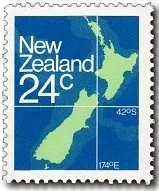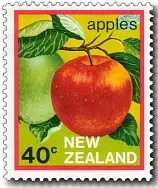Definitives Tour.

Black printed double. (See enlargement lower down this page.)
In this second Post on the 1982 - 1985 Definitives I want to look at the subject of each stamp and also provide a few printing errors as well. Again I have treated these as separate issues on the one page.
1982 Definitives - Map.
24c - New Zealand Map with Latitude / Longitude Lines.
The 24c map stamp was issued as a result of a change in postage rates. This stamp depicts a map of New Zealand with longitude and latitude marking the country's position in the South Pacific. It is a very simple design of only 2 colours to save costs because 24c, being the standard letter postal rate, meant larger quantities would be required.
A collection of five stamps with flaws that appear as extra islands or in the case of the centre stamp an extra lake. These flaws were caused by dirt, often paper fluff, sticking to the surface of the printing plate. These stamps were printed with a process known as lithography which was very susceptible to this type of flaw.
24c Map stamp on cover. Flaw - an extra island to left of South Island.
1982 Definitives - Minerals.
1c - Nephrite / Jade.
The mineral nephrite is also known as jade. In New Zealand, nephrite can be found on the West Coast between Hokitika and Greymouth and in beach deposits as far north as Punakaiki; it is always known locally as 'greenstone'.
Nephrite jade (greenstone) in New Zealand is known as pounamu in the Māori language, and is highly valued, playing an important role in Māori culture. Weapons and ornaments were made of it; in particular the mere (short club), and the hei-tiki (neck pendant). These were believed to have their own mana, were handed down as valuable heirlooms, and often given as gifts to seal important agreements. It was also used for a range of tools such as adzes, as Māori had no metal tools.
1c - Nephrite / Jade, a huge perferation error.
2c - Agate.
Agate is one of a variety of mineral quartz and belongs to the largest class of minerals - the silicates. In New Zealand, agate is widely distributed - the main locations being Northland, Coromandel Peninsula, Canterbury and North Otago.
Although agates may be found in various kinds of rock, they are classically associated with volcanic rocks and can be common in certain metamorphic rocks.
2c - Agate, offset.
Left-hand is a normal copy but on the right wet ink has offset (transferred) on to the sheet above.
3c - Iron Pyrites / Fool's Gold.
Iron pyrites is the most common sulphide mineral known as "fool's gold". Iron pyrites are usually mined today for their sulphur content - 40 percent of the world's sulphur is obtained by this method. Iron pyrites were found in many areas of New Zealand during the quartz gold mining era and are still found in Hauraki, Westland, Nelson and Canterbury. Because it had the appearance of gold it was known by the miners as "fool's gold."
4c - Amethyst.
Amethyst is one of a variety of mineral quartz and belongs to the largest class of minerals - the silicates. In New Zealand amethyst is widely distributed - the main locations being Northland, Coromandel Peninsula, Canterbury and North Otago. Good quality amethyst has come from the Coromandel Peninsula, Rakaia Gorge and Mount Somers.
5c - Carnelian.
Carnelian is one of a variety of mineral quartz and belongs to the largest class of minerals - the silicates. In New Zealand, carnelian is widely distributed - the main locations being Northland, Coromandel Peninsula, Canterbury and North Otago.
9c - Native Sulphur / Brimstone.
Native sulphur is the chief source of the element Sulphur and it is usually found in areas associated with volcanoes and geothermal activity. It is this mineral which was known as "brimstone" or "the stone that burns" because of its habit of burning readily. Sulphur was first mined in New Zealand on White Island in 1885. It is also located on Whale Island and in the Rotorua district with the largest known deposit being at Lake Rotokaua, north-east of Taupo.
Brimstone is a very old name for Sulphur going right back to ancient writings such as the Bible.
Special Cover.
A 1989 cover sent to Denmark with the six mineral definitives.
Other stamps include the 1977 Vintage Firefighting; 1985 35c Health; 1989 Health (3 values).
1983 Definitives - Fruit.
10c - Grapes.
New Zealand's climate and soils are its key assets that enable it to produce outstanding table wines. Around the world, the finest wines are grown in regions with relatively cool climates where grapes are able to ripen fully but slowly, retaining their refreshing acidity while building up their most subtle aromas and flavours. New Zealand's 'cool climate' is its major viticultural advantage.
Today (2016) much of New Zealand's production goes into wine with a large variety of grapes grown especially for specific wines.
20c - Citrus Fruits.
Three types of citrus fruit feature on this stamp - a tangelo, a grapefruit and a lemon. While New Zealand still imports much of its citrus fruit requirements, production of export tangelos and lemons is increasing.
30c - Nectarines.
There are several types of nectarines produced in New Zealand, the Fantasia and the Red Gold varieties are featured on this stamp.
40c - Apples.
Apples are one of New Zealand's bigger export earners. An old (Granny Smith) and a new (Braeburn) variety feature on the stamp.
50c - Kiwifruit.
The kiwifruit is one of New Zealand's most successful export products.
Kiwifruit is native to north-central and eastern China. Cultivation of the fuzzy kiwifruit spread from China in the early 20th century to New Zealand, where it was crossbreed and selectively improved until soon the first commercial plantings occurred. The fruit became popular with American servicemen stationed in New Zealand during World War II and later exported to California using the names "Chinese gooseberry" and "melonette". In 1962, New Zealand growers began calling it "kiwifruit" to give it more market appeal, and a California-based importer subsequently used that name when introducing the fruit to the American market.
A new variety, the gold kiwifruit, a hairless fruit with yellow flesh inside, has become popular in New Zealand,
1985 Definitives - Queen Elizabeth II.
25c - Queen Elizabeth II on Red Background.
Arising from increased postage rates, two new definitive stamps were issued in July 1985. Each stamp featured Her Majesty the Queen Elizabeth II with the design being adopted from a recent portrait by Camera Press, England. The Queen was depicted wearing the Queen's Service Order, instituted in 1975; the Order, and associated Queen's Service Medal, are distinctive to New Zealand but an integral part of the Royal Honours System.
35c - Queen Elizabeth II on Blue Background.
New Zealand is a Sovereign Independent State, with a Parliamentary Government and a constitutional monarchy. As such, New Zealand is entirely separate from the United Kingdom but the Crown is vested in the same person, Queen Elizabeth II, who is 'Queen of New Zealand'. Her Majesty became the first 'Queen of New Zealand' by the Royal Titles Proclamation 1953. Under the Royal Titles Act 1974 she became 'Queen of New Zealand' in her own right. The Monarch is represented in New Zealand by a Governor-General who is appointed for a fixed term on the advice of the Government.
Flaws in the 25c Queen Elizabeth Red.
(These examples have been enlarged to better display the flaws.)
Above - The black has been printed twice giving a general blurring of the portrait and doubling of the writing.
Below - Block of four with the Queens Service Order missing on blue lapel.
Some of the images in this post were used with permission from the illustrated catalogue of Stamps NZ
You can visit their website and On-line Catalogue at, http://stampsnz.com/
Some Information or images for this post came from.





















We appreciate your engagement with our content. To ensure a respectful and constructive community, please take note of the following:
- No Spam, Please: We do not tolerate spammy or promotional comments. Any such comments will be promptly removed.
- Moderation in Place: All comments are moderated to maintain a positive and inclusive environment. Please be patient, as it may take a little time for your comment to appear.
- Sign In with Google: To comment, please sign in using your Google account. This helps us maintain the integrity of our community and allows for better interaction.